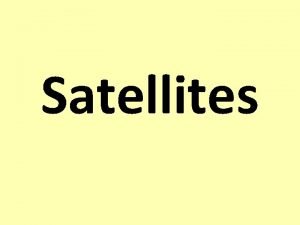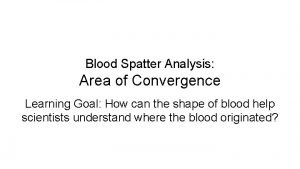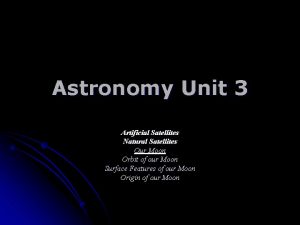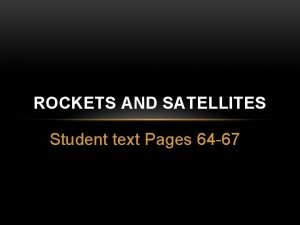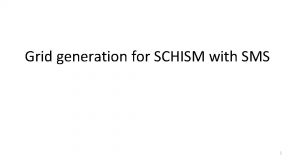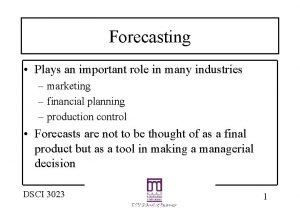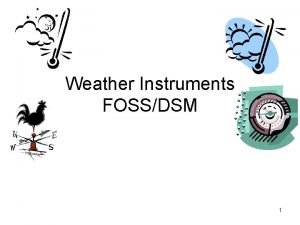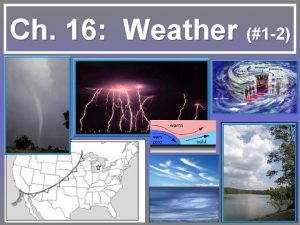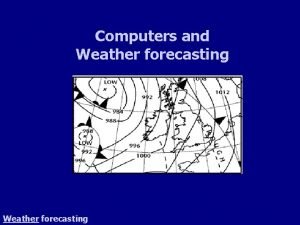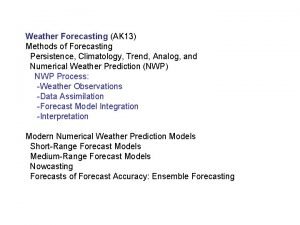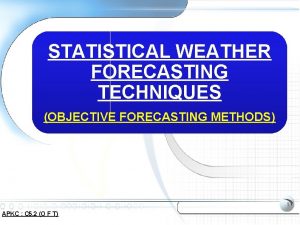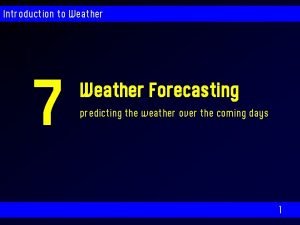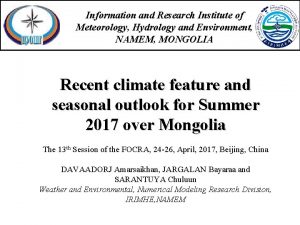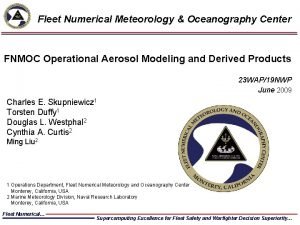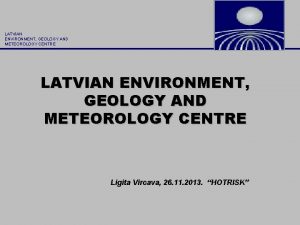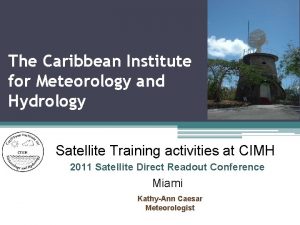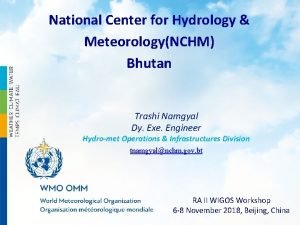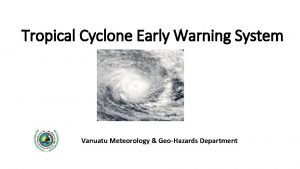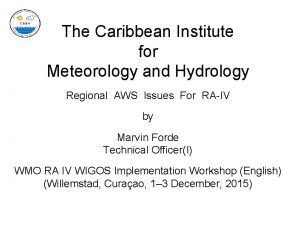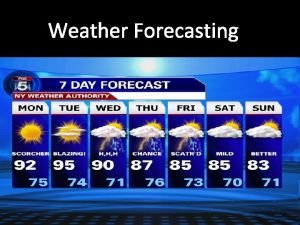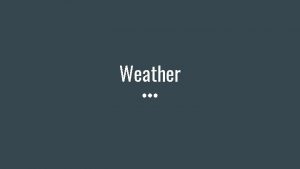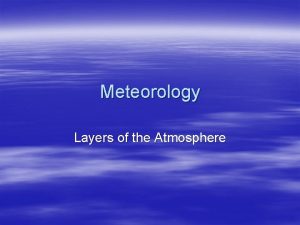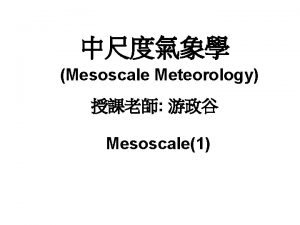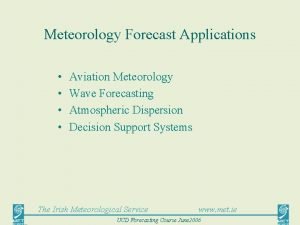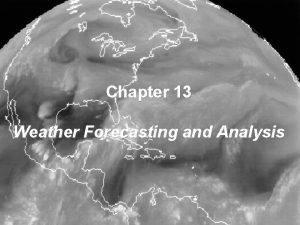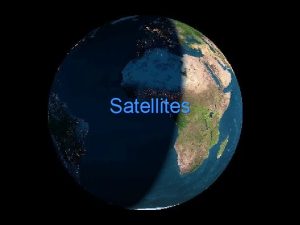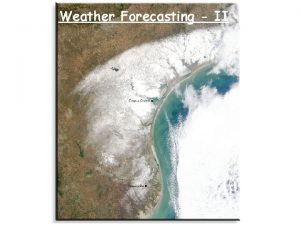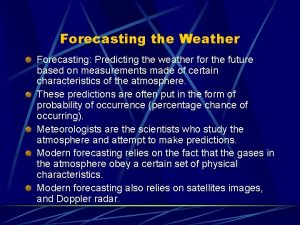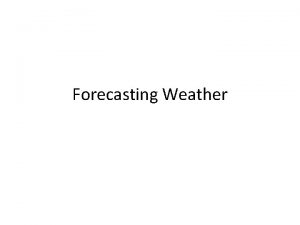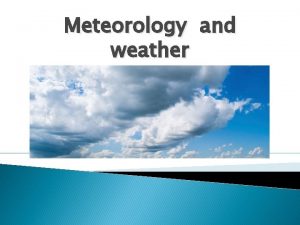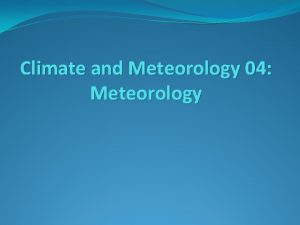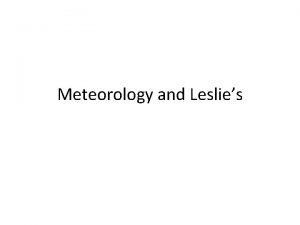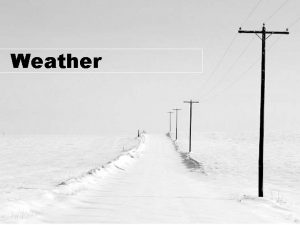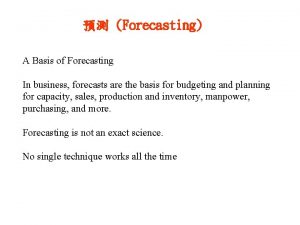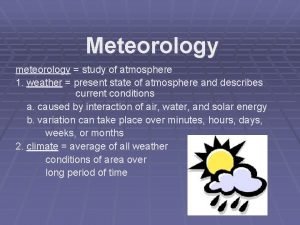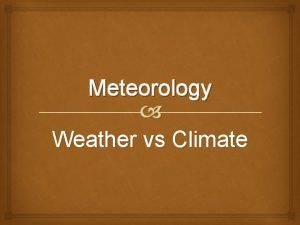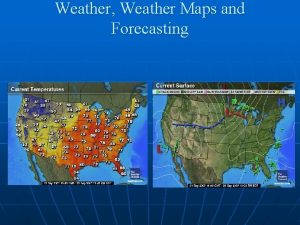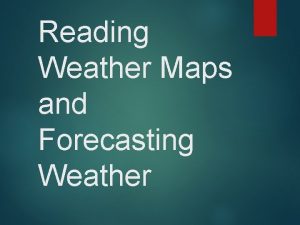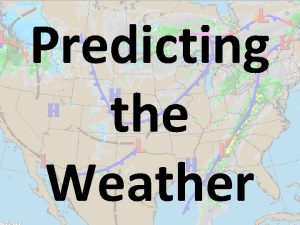Satellites for Meteorology and Weather Forecasting Weather forecasts


























- Slides: 26

Satellites for Meteorology and Weather Forecasting Weather forecasts Meteorological model Observations data assimilation (‘initial conditions’) Ross Bannister High Resolution Atmospheric Assimilation Group, NERC National Centre for Earth Observation, University of Reading, UK, r. n. bannister@reading. ac. u

How do satellites help in understanding and forecasting weather events? There is a huge demand for up-to-date knowledge about the Earth system 1 Model forecasts stray from reality over time (chaotic destruction of knowledge). The ‘butterfly effect’. 2 The world is a very large place! Volume of atmosphere: 5 billion km 3. Issues with use of satellite data for numerical weather prediction (NWP) 1 2 3 ES 4 Spring School, April 2013 Satellites don’t measure directly meteorological quantities (winds / temperature / humidity / etc). These have to be inferred for use with models: data assimilation. Qualitative information from satellites (‘satellite pictures’) help us see the evolving atmosphere, but doesn’t satisfy this demand. Satellite data need to be treated quantitatively to be useful for numerical weather forecasting. Satellites for Meteorology and Weather Forecasting Page 2/26

Types of weather measurements not comprehensive! Coverage Instrument Quantities Spatial Resolution Temporal Horiz. Vert. In-situ instruments Radiosondes u, v, T, p, q, (O 3) Cont. N. H. , t-sphere 6 hourly point Surface stations u, v, T, p, q Continental surface 6 hourly point n/a Aircraft u, v, T, p, q Flight paths, airports In flight point Drifting buoys u, v, T, p Drift paths, sea level hourly point n/a Geostationary satellites Rad: MW, IR, Vis Global 15 -30 mins > 10 km many kms Polar orbit satellites (nadir) Rad: MW, IR, Vis Global Continuous 100 s m many kms Polar orbit satellites (limb) Rad: MW, IR, Vis Global Continuous 100 s km 1 -2 km Scatterometer Radar backscatter Oceans Continuous 50 km n/a Radio occultation GPS phase shifts Global ~ hourly 150– 300 km 1 km Ground-based radar Radar reflectivity / Dopler shift N. Am. , Eu. , Australia. 200 km from antenna 10 mins Remote sensing instruments 'Rad'=radiances, 'MW'=microwave, 'IR'=infrared, 'Vis'=visible ES 4 Spring School, April 2013 for Meteorology and Weather Forecasting In operational global weather forecasting there Satellites are ~108 observations assimilated per cycle ~ 1° Page 3/26

Coverage maps for NWP Courtesy Met Office ES 4 Spring School, April 2013 Satellites for Meteorology and Weather Forecasting Page 4/26

Contents PART A history of satellites for weather forecasting / Earth observation What does a satellite ‘see’? B PART Types of satellite orbit / viewing geometry / instrument C PART Example imagery D PART Deriving useful information from satellite measurements E ES 4 Spring School, April 2013 Satellites for Meteorology and Weather Forecasting Page 5/26

) sta tion ary ge o sta tion t. S G( eo o. S a ete et. O p –M 20 06 -M 04 20 78 19 –S 74 19 –M (ge MS 3 us imb –N 69 19 ete o. S at (g ost (ge TS –A 66 60 19 Ap r ES 4 Spring School, April 2013 19 –T IRO ore r xpl –E 59 19 Au g S 1 6 2 ard gu Va n 9– 95 b 1 Fe ost atio n ary ) not comprehensive! ary ) A history of satellites for weather forecasting Satellites for Meteorology and Weather Forecasting Page 6/26 First picture of Earth from TIROS-1

www. sat. dundee. ac. uk Sequences of satellite pictures (visible) SEVIRI channel 1, 0. 56 – 0. 71 μm Courtesy NERC Satellite Receiving Station, University of Dundee ES 4 Spring School, April 2013 Satellites for Meteorology and Weather Forecasting Page 7/26

‘radiance’ measured by satellite Information from satellite measurements over other parts of the EM spectrum 12. 0 µm - information on temperature near the surface to ~3 km Max Planck 9. 7 µm - information on temperature at ~13 km Thermal emission from body at 300 K 7. 3 µm - information on temperature at ~3 to ~8 km Wavelength 10 -6 m (µm) ES 4 Spring School, April 2013 Satellites for Meteorology and Weather Forecasting Page 8/26

www. sat. dundee. ac. uk Sequences of satellite images (visible + infrared) SEVIRI channel 1, 0. 56 – 0. 71 μm SEVIRI channel 10, 11 – 13 μm Courtesy NERC Satellite Receiving Station, University of Dundee ES 4 Spring School, April 2013 Satellites for Meteorology and Weather Forecasting Page 9/26

www. sat. dundee. ac. uk Sequences of satellite images (visible + infrared + water vapour) SEVIRI channel 1, 0. 56 – 0. 71 μm SEVIRI channel 10, 11 – 13 μm SEVIRI channel 6, 6. 85 – 7. 85 μm Courtesy NERC Satellite Receiving Station, University of Dundee ES 4 Spring School, April 2013 Satellites for Meteorology and Weather Forecasting Page 10/26

Flow regimes ES 4 Spring School, April 2013 Satellites for Meteorology and Weather Forecasting Page 11/26

Geostrophic balance Gaspard-Gustave de Coriolis ES 4 Spring School, April 2013 Satellites for Meteorology and Weather Forecasting L Page 12/26

Orbit configurations 12 Polar orbit • 600 - 800 km above sea level typically. • Near-global coverage over time. • Non-continuous sampling of a given location. • Often used for sounders (e. g. on board Envi. Sat, EOS Aura, etc). ES 4 Spring School, April 2013 Geostationary orbit • 35 786 km above sea level, latitude 0. 0°. • View 1/4 of Earth's surface (60 S-60 N). • Continuous sampling of a given location. • Often used for imagers (e. g. on board Meteo. Sat, etc). • Horiz. resolution degrades poleward. Satellites for Meteorology and Weather Forecasting Page 13/26

Viewing geometries Limb • Good vertical resolution possible (~1 km). • Poor horizontal resolution. • Used mainly in research. ES 4 Spring School, April 2013 Nadir • Good horizontal resolution possible. • Poor vertical resolution (several km). • Used mainly in operational weather forecasting. Satellites for Meteorology and Weather Forecasting Page 14/26

Satellite ‘imagers’ vs ‘sounders’ Imager: • An instrument that measures a signal with spatial resolution. • On board geostationary and polar orbiting satellites. • Nadir viewing only. Sounder: • • An instrument that measures a signal with spectral resolution. On board mainly polar orbiting satellites. Nadir or limb viewing. Can be processed to give quasi-height resolved retrievals of T, q, O 3, etc. (used heavily for numerical weather prediction). ES 4 Spring School, April 2013 Satellites for Meteorology and Weather Forecasting Page 15/26

not comprehensive! Selection of instruments List of more acronyms at www. met. rdg. ac. uk/~ross/DARC/Acronyms. html ES 4 Spring School, April 2013 Satellites for Meteorology and Weather Forecasting Page 16/26

Other types of satellite instrument Scatterometer ES 4 Spring School, April 2013 Radio occultation Satellites for Meteorology and Weather Forecasting Page 17/26

Forecast accuracy • Take the average accuracy of a 1 -day forecast in 1980. • How long does a forecast have to be (subsequently) to achieve this accuracy? Courtesy Met Office ES 4 Spring School, April 2013 How close is forecast to latest analysis? Northern hemisphere Southern hemisphere Courtesy ECMWF Satellites for Meteorology and Weather Forecasting Page 18/26

Example imagery – polar lows 06/04/2007, MODIS 30/03/2013, MODIS Courtesy NERC Satellite Receiving Station, University of Dundee ES 4 Spring School, April 2013 Satellites for Meteorology and Weather Forecasting Page 19/26

Example imagery – frontal systems 31/01/2008, MODIS 08/12/2011, MODIS 22/03/13, AVHRR Courtesy NERC Satellite Receiving Station, University of Dundee ES 4 Spring School, April 2013 Satellites for Meteorology and Weather Forecasting Page 20/26

Example imagery - thunderstorms 30/10/2008, AVHRR 24/04/2008, MODIS Courtesy NERC Satellite Receiving Station, University of Dundee ES 4 Spring School, April 2013 Satellites for Meteorology and Weather Forecasting Page 21/26

Example imagery - hurricanes 29/08/2005, GOES-E 29/10/2012, GOES-E Courtesy NERC Satellite Receiving Station, University of Dundee ES 4 Spring School, April 2013 Satellites for Meteorology and Weather Forecasting Page 22/26

Example imagery - anticyclones 09/12/2001, MODIS 21/09/2006, MODIS Courtesy NERC Satellite Receiving Station, University of Dundee ES 4 Spring School, April 2013 Satellites for Meteorology and Weather Forecasting Page 23/26

Example imagery – other features of interest 03/04/2011, MODIS 07/05/2010, MODIS 20/03/2009, AVHRR 27/03/13, AVHRR Courtesy NERC Satellite Receiving Station, University of Dundee ES 4 Spring School, April 2013 Satellites for Meteorology and Weather Forecasting Page 24/26

compare simulated with measured spectra Measured brightness temperature (K) Simulated brightness temperature (K) Deriving useful information from satellite data wavenumber (cm-1) simulate spectrum adjust atmospheric profiles for greater agreement (retrieval / assimilation theory) Estimation of atmospheric state refined with information from measured spectrum Temperature water vapour ES 4 Spring School, April 2013 O 3 Satellites for Meteorology and Weather Forecasting Page 25/26

Courtesy NERC Satellite Receiving Station, University of Dundee SEVIRI channel 6, 6. 85 – 7. 85 μm Ref: From Sputnik to Envi. Sat, and beyond: The use of satellite measurements in weather forecasting and research Brugge & Stuttard, Weather 58 (March 2003), 107 -112; Weather 58 (April 2003), 140 -143. ES 4 Spring School, April 2013 Satellites for Meteorology and Weather Forecasting Page 26/26
 As compared to long-range forecasts, short-range forecasts
As compared to long-range forecasts, short-range forecasts Lesson outline lesson 3 answer key
Lesson outline lesson 3 answer key Compare and contrast weather
Compare and contrast weather Solar power satellites and microwave power transmission
Solar power satellites and microwave power transmission Uses of polar satellites
Uses of polar satellites Exhibition for satellites
Exhibition for satellites Blood activity - area of convergence
Blood activity - area of convergence Natural satellite
Natural satellite Satellites in orbit around earth continually fall toward
Satellites in orbit around earth continually fall toward Skew and schism
Skew and schism Forecasts play an important role in
Forecasts play an important role in What does a wind vane measure
What does a wind vane measure Ch 16 weather
Ch 16 weather How are computers used in weather forecasting
How are computers used in weather forecasting Persistence weather forecasting
Persistence weather forecasting Weather forecasting techniques
Weather forecasting techniques Introduction to weather forecasting
Introduction to weather forecasting Weather and climate brainpop
Weather and climate brainpop Meteorology hydrology and water management
Meteorology hydrology and water management Fleet numerical meteorology and oceanography center
Fleet numerical meteorology and oceanography center Latvian environment geology and meteorology centre
Latvian environment geology and meteorology centre Caribbean institute for meteorology and hydrology
Caribbean institute for meteorology and hydrology Nchm bhutan
Nchm bhutan Vanuatu meteorology and geohazards department
Vanuatu meteorology and geohazards department Caribbean institute for meteorology and hydrology
Caribbean institute for meteorology and hydrology Formuö
Formuö Typiska drag för en novell
Typiska drag för en novell




